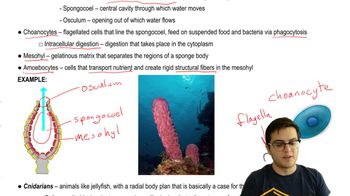Here are the essential concepts you must grasp in order to answer the question correctly.
Phylum Echinodermata
Echinodermata includes marine animals such as starfish and sea urchins, characterized by radial symmetry in adults and bilateral symmetry in their larval stages. They possess a coelom, which is a fluid-filled body cavity that allows for the development of complex organs. Understanding this phylum is crucial for identifying the correct characteristics associated with it.
Recommended video:
Body Cavities: Coelomate, Pseudocoelomate, Acoelomate
Body cavities are classified into three main types: coelomate (organisms with a true coelom), pseudocoelomate (organisms with a body cavity that is not entirely lined by mesoderm), and acoelomate (organisms lacking a body cavity). This classification is essential for understanding the structural organization of different phyla, including Nematoda, Platyhelminthes, and Porifera.
Recommended video:
Phylum Porifera
Porifera, commonly known as sponges, are simple aquatic animals that lack true tissues and organs. They do not possess a gastrovascular cavity; instead, they filter feed through a porous body structure. Recognizing the unique characteristics of Porifera is vital for distinguishing them from other phyla and understanding their biological classification.
Recommended video:






